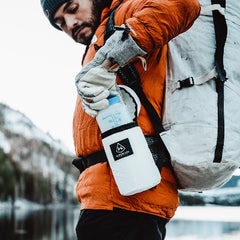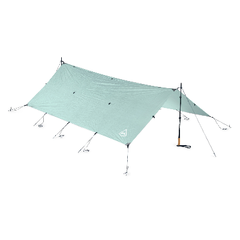Words & Photos by Eloise Robbins
Do you know how much twelve days of food weighs? I don’t. I stubbornly refused to find out, my pack bulging at the seams with every last calorie I could cram into it. I figured if I didn’t know how heavy it was, it would feel lighter. But now, staring at my towering pack in a Jasper, Alberta, Canada hostel room, I wasn’t even sure if I could lift it, never mind hike over 350 kilometers with it on my back.
I’ve spent most of my hiking career whittling down my base weight. A light pack is essential for everyone, but at 5’2”, it’s especially important for me. A ten-pound backpack is a much larger proportion of my bodyweight than for someone a foot taller than me. I can hike further with a light pack, with less fatigue. I worry less about an injury. Then again, if you’re reading this on Hyperlite Mountain Gear’s website, I don’t have to persuade you. You know just how crucial ultralight gear is for big days in the mountains. But a ten-pound base weight doesn’t mean anything if you add 25 pounds of food. And I had a nasty feeling that’s what I’d just done.
I’ve always brought a little more food than I need to. There’s a saying on the trail that you carry your fears. Hikers worried about being cold bring extra layers. People afraid of getting hurt carry more first aid supplies. If you’ve ever experienced hiker hunger–that ravenous desire to sit down and consume everything in your pack or eat four cheeseburgers in a row, you know how savage it can be. I always stashed extra snickers bars in my pack or brought more trail mix than I needed. Not being able to satiate that intense hunger frightened me. But this time, I’d loaded every single calorie I could. Food still overflowed from every pocket on my Windrider, despite the 55-liter capacity. I just simply couldn’t lift my pack if I added any more.

I hauled my pack up, resting it on my knee, then bouncing it to my back. I didn’t immediately tip over backward, although I could feel the weight press me down into the earth. I opened the hostel door and stepped out. After five steps, my body adjusted. After five minutes, I could almost forget just how much weight was on my back. My pack had become an old friend over the past month of hiking. She had hugged me close on rugged ridgelines. She had protected my gear through thick alder and willow bushwhacks. She had been with me through intense heat, wind, and rain. I’d started to anthropomorphize her in the way that only people who have been in the woods for too long can do. But now, I was asking more of her than I’d ever had to. One last section: 350 kilometers or 220 miles through some of the most remote terrain in the Canadian Rockies. No options for resupply. Very few ways out if something went wrong. I knew she could handle the weight: I wasn’t sure if I could.
Six days later, I’d forgotten my pack was ever heavy. I’d eaten down my carefully planned food, trying not to consume too much or too little. Now, she was a manageable weight. Six days of food remained–a normal amount to carry on the rugged Great Divide Trail. I felt light like I could fly over the mountains. I didn’t realize I was about to be stopped in my tracks.
It started as a gentle rain, little more than mist on the summit of a steep, shale-covered peak. The droplets got bigger, heavier, and fatter. Soon, I couldn’t tell if they were rain or snow, sleet melting as it hit the ground. By the time we reached camp, we were soaked. Our rain gear had held off the water for a while, but it had seeped through, and my hiking clothes were dripping wet. To complicate matters more, the rain had turned entirely to snow. We’d found a meadow to set up camp in, and the high peaks around us were already dressed in white. The snow started to accumulate around us: thick, heavy, and wet. I shivered my way into my sleeping bag and tried not to think about our food situation.

We woke up to a blanket of snow. It still fell, fat flakes drifting down lazily. Hiking seemed out of the question. We had five days of food left and five days of hard hiking remaining–two on the GDT itself and then another three to the closest highway on ATV tracks and deserted forest roads. We might find someone to give us a ride out, but it seemed unlikely. So we hid in the tent until midafternoon when the snow finally stopped. The wind chased the clouds. A few sunbeams shone on our little camp, though there was no heat to them. We started a fire, hanging our wet clothes around it to dry. And then I spread out our food.

There was no question that our coffee situation was dire. We’d run out long before we reached civilization. But we seemed to have enough food if we were careful. I had packed my fears after all. We wouldn’t starve, despite being a day behind schedule. We’d be ok. Maybe a little hungry, but nothing dangerous.
We spent the rest of the day drying our wet gear. In the morning, we packed up and hiked through the wet snow. The sun emerged from behind the mountains, and fat chunks of slush fell from the trees in the warmth. Summer returned to the mountains, winter melting away. We hiked as fast as we could, impatient for town food, warm beds, and dry socks, even if it meant an end to our adventure. The snow had been a reminder that hiking season is fleeting this far north. It was time to go home.

Five days later, I emptied my food bag onto a hotel room floor. Six candy bars, an oatmeal packet, and a much-hated couscous dinner tumbled out. We’d survived my longest ever food carry with calories to spare. I’m not in a hurry to ever carry that much food again. But I know now that if I have to, my pack and I can take the weight.
Eloise Robbins is a Triple Crowner who completed the Continental Divide Trail in 2017. She also enjoys canoeing, bikepacking, and getting outdoors all winter long. You can read more of her writing at https://funsizehikes.com.


















